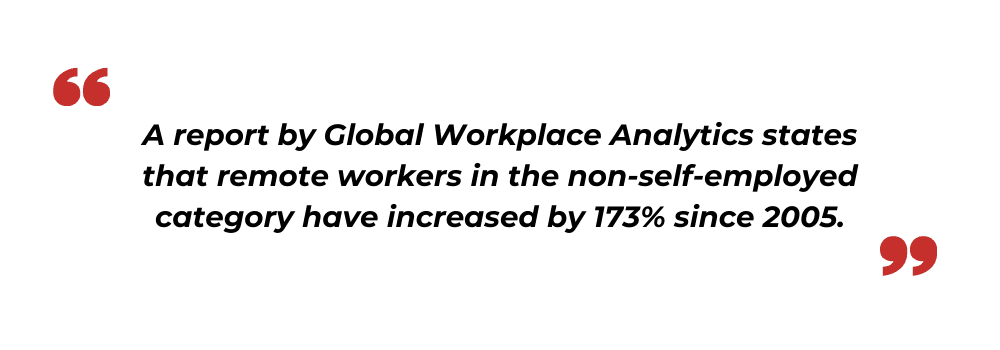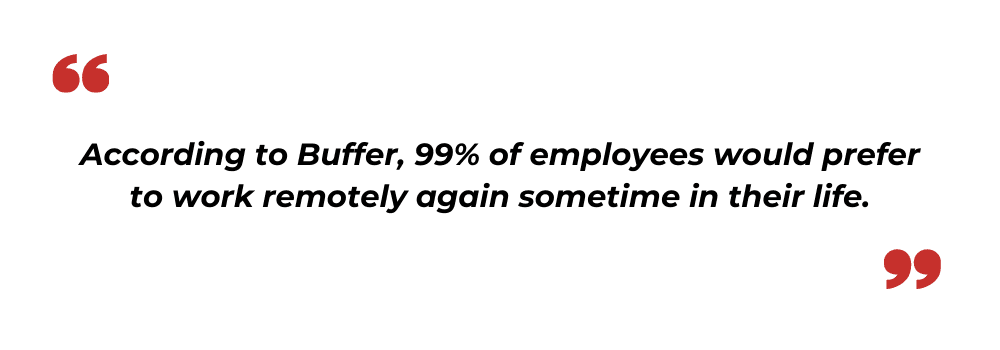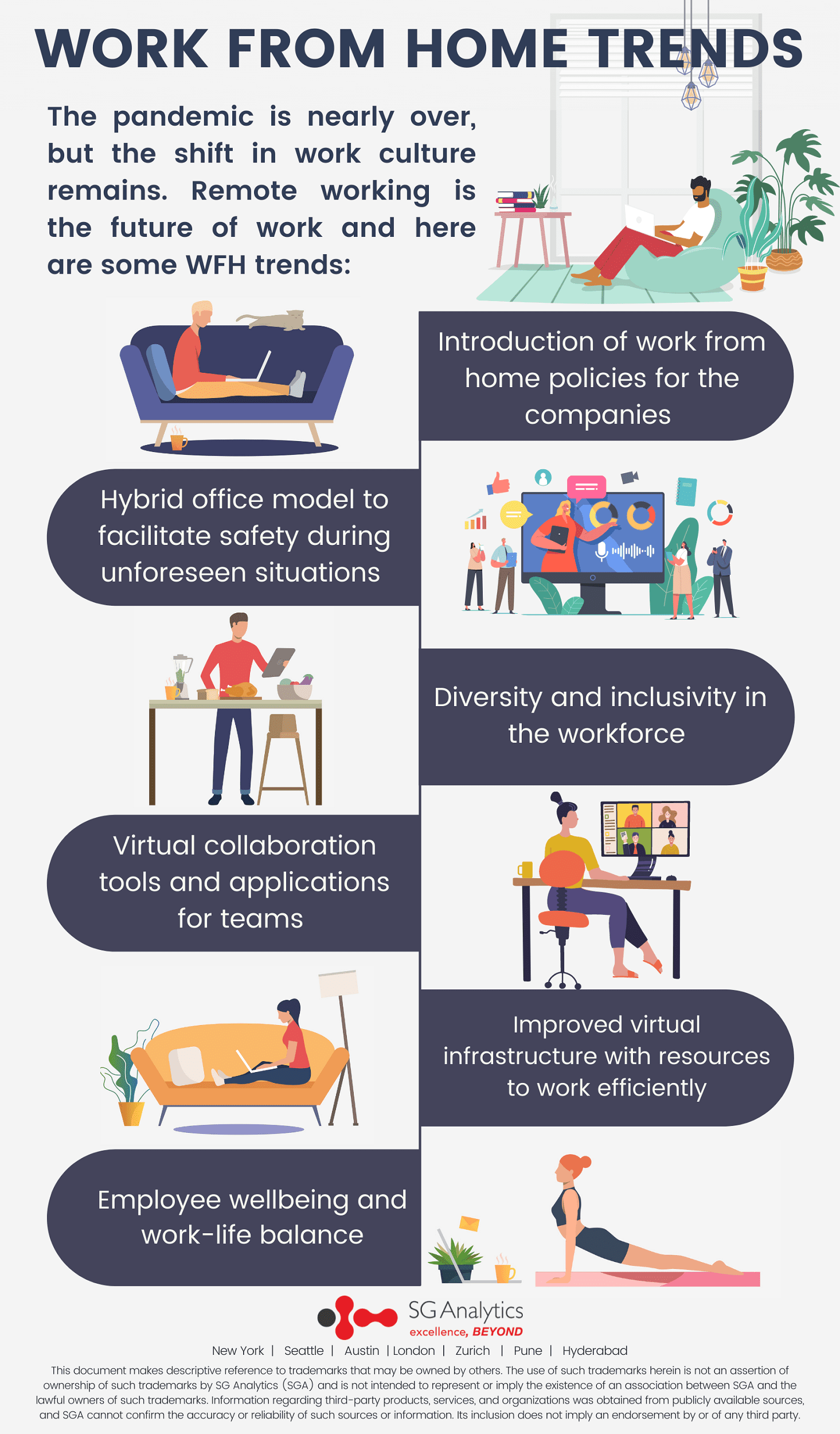The coronavirus pandemic continues to bring agony and despair for multitudes across the world, building huge financial and emotional strains. While the science fraternity works relentlessly toward developing a vaccine, countries across the globe are actively working toward suppressing the rising number of cases. Simultaneously, business organizations, having being aware of the dangers the virus poses toward the safety of their employees, have been mindful of their responsibilities and have continuously encouraged employees to work remotely over the span of the last 18 months. In order to have some semblance of normalcy and maintain business as usual, businesses have been exploring various digital options of responsibly carrying out their operations. Several companies have revamped their workplace policies and are now giving special attention to remote working. As millions of people adjust to working remotely from home on a full-time basis, the transition has had its own set of challenges as we humans are hardwired for social connections, and being locked down for more than a year is something that no one saw coming.
The days are gone when organizations required their workforce to be physically present at their offices. Today, businesses are preferring to operate in a more diverse manner by integrating work from home setup as well as in-house employees. Due to the pandemic, the workplace collaboration software space has witnessed a huge rise in demand. To make work from home online flawless, several workplace collaboration tool/software providers have perfected their offerings in order to help everyone adapt to the “new normal”. For smooth business operations, it is essential that in-house employees, remote workers, third-party vendors, and independent contractors stay connected to each other. The dramatic move towards remote working has undoubtedly highlighted the need for virtual collaboration tools – the only way employees can work as a team.
Impact of Coronavirus on remote working from home
The Covid-19 pandemic has reset several work trends. This situation of crisis has compelled HR leaders to brainstorm workforce planning and management. The pandemic has given remote working from home an “ultimate push” and has redefined the definition of work from home, creating a lasting impact on the way we work. Companies who work from home are in the midst of re-evaluating their strategic and operational goals while assessing the impact on their pre-Covid goals and plans. According to Gartner, in order to lower costs, 32% of organizations are looking forward to replacing full-time employees with remote workers.

Brian Kropp, VP Gartner, points out that large-scale shifts are transforming the way people work and how organizations get things done. Effective response by businesses can ensure safe navigation through the pandemic and establish a competitive advantage. Today more than ever, people across the globe are acknowledging “worker well-being” – an important aspect of working remotely. Since the blurring of boundaries between personal and professional life is creating unwanted stress in an employee’s life, people are now focusing on balancing their remote work and personal life better.
A report by Global Workplace Analytics states that remote workers in the non-self-employed category have increased by 173% since 2005. Even though the trend of working remotely was moving upward gradually since the last decade, most companies who work from home were reluctant to embrace it. Technology challenges and rigid mindset being the two primary reasons why several companies displayed resistance to remote working. Many companies lacked the required technology infrastructure and didn’t want to risk their operational security, as well as rigid workplace policies, made it difficult for the employees to work remotely. Now, companies who work from home have no choice other than being inevitably dependent on workplace collaboration tools and introduce a remote working policy to ensure smooth business operations.
Remote working trends 2021
Now that work from home online is the newly formed workplace – an amalgamation of work and private life, various new trends have shaped up. Since, working remotely is here to stay, and is not a passing trend; millions of people across the world are now demanding flexible remote work options. This new way of life appears to be a tidal wave that dominated 2020 but may also dominate the years beyond.

Here are some future trends for remotely working:
Demand for Work from Home opportunities is growing
Previously viewed as a luxury that was mostly restricted to upper management and few other employees in an organization, the definition of work from home has evolved so as to blend with the new work environment. According to a survey by LinkedIn, 82% of employees prefer working remotely at least once a week while 57% of them prefer working remotely at least thrice a week.
“Hybrid” offices on the rise
A fusion of in-house and remote employees is a trend that most companies who work from home will adopt. In order to tackle isolation and productivity challenges, organizations are looking forward to establishing a “hybrid” work environment where employees will toggle between working from the office and their homes. Since the entire workforce can’t be in the same location as of yet, businesses are open to hiring permanently remote workers. A study by Global Workplace Analytics reveals that by hiring remote workers, businesses could save up to $11,000 per employee each year. A report by Buffer states that 44% of employees admit that they have full-time remote workers as a part of their team.
Services, tools, and resources enabling remote work to grow persistently
Workplace collaboration services and tool providers that are facilitating remote working will witness an upward growth path persistently. In March, Microsoft Teams had 44 million daily active users and its total video calls grew by 1000% while Zoom recorded 200 million daily meeting participants during the same period. By mid-April, Zoom had 300 million daily meeting participants. In June, daily active users on Microsoft Teams were recorded to be over 75 million.

Increased focus on employee well-being
Several companies who work from home are beginning to recognize the humanitarian aspect during this pandemic and are focusing on employee well-being – treating them as people, not workers. But many companies are still pushing their employees to work in high-risk conditions with minimum or no support – treating them first as workers and second as people. A mindful approach by organizations can enhance employee experience and build an inclusive work culture. Employers now have an extended role in ensuring their employees’ physical, mental, and financial well-being.
Top-tier employers to take center stage
The coronavirus pandemic has resulted in prospective and current employees judging organizations on the basis of their behavior toward employees during this period. Top talent will prefer working with organizations that are transparent and have flexible timings, and work from home policy in place. The decisions taken by businesses during this crisis period will have a long-term impact on their ‘employer’ brand image. Top-tier organizations that are giving importance to employees will emerge as winners.
Diversity and inclusivity in teams has increased
Organizations are beginning to actively embrace the modern cultural shift by ensuring diversity in teams. Now that location is not a constraint anymore, companies who work from home are willing to hire the right talent across different cities in the country – or perhaps across the globe. The attitude change toward inclusivity has encouraged companies to adapt to the modern ways of working.
Feature-rich workplace collaboration tools for a changing workforce
With multiple players in the collaboration software market, the service providers have been adding various additional functionalities in order to address the demands of the masses to improve work from home setup as well as organizations. Microsoft Teams, Zoom, Cisco WebEx, Slack, etc. are adding features such as single sign-on, one-click provisioning, integration directory, and third-party application marketplace.
Microsoft Teams
One of the most popular workplace collaboration tools, Microsoft Teams, had witnessed a sharp jump from 32 million daily active users to 44 million in just one week. In March, the company saw a 1000% growth in video calls, clocking a new record of 2.7 billion meeting minutes in a day. Microsoft Teams boasts about its integrated solutions with features such as persistent chat, channels, mentions, custom notification settings, collaborative document editing, meeting management including notes, call recording, and integration with its Outlook and Office products. Microsoft is strengthening its infrastructure capabilities to ensure enough capacity for new users.
Zoom
A booming collaboration tool majorly for young professionals and students, Zoom recorded 300 million daily meeting participants by the end of April 2020. That’s a massive jump from 10 million daily meeting participants in December 2019. The unpredictable success led to various security and privacy concerns but overall, the company responded with adequate measures and is maintaining its growth momentum.

Cisco WebEx
Cisco’s WebEx product is another popular workplace collaboration tool in the market, offering video conferencing and added essential collaboration features such as instant messaging, brainstorming tools, media and content sharing, webinars, and call sharing. Amid the pandemic, Cisco recorded 324 million users in March. According to Cisco Collaboration’s Senior VP and General Manager, Sri Srinivasan, the company has seen 2.5x, 4x, and 3.5x growth in the Americas, Europe, and Asia-Pacific, respectively.
Slack
In order to reach the masses, Slack has made the paid version of its app free for everyone who has played an essential role in curbing the pandemic. Initially developed as an internal tool for a gaming company, Slack gained massive popularity because of its deep engagement and intuitive and appealing user interface (UI).
Work from home pros and cons
Pros:
Attracting top talent: Remote working has expanded the horizon for attracting the top talent pool. Now that companies who work from home aren’t restricting themselves to a specific geographical area, they can find specialized professionals from across the globe.
Reduced employee turnover: Organizations are using remote working as a way to retain top talent. It has proven to be a valuable retention tool in the past. A report by Owl Labs states that organizations that offer remote working opportunities experience a 25% less employee turnover rate. Replacing highly trained employees can cost twice the annual salary of the employee.
Increased productivity and team collaboration: The results from a poll by Gallup reveals that employees who spent 60% to 80% of their time away from the office, were having the highest rates of engagement. During this pandemic, some are finding working remotely far less distracting, while others living with families are finding it hard to focus on work. But overarchingly, employees have been far more productive than they were earlier.
Cons:
Difficulty in setting boundaries: Extended work from home is starting to create anxiety and stress for many people as the boundaries between work and private life have merged. The constant need to be available online while working remotely, instant messaging, or other workplace collaboration tools is acting as a source of stress. To overcome this, organizations can communicate boundaries by, say, setting defined “working hours”.
Feeling isolated: In pre-Covid times, having a chat with other colleagues would nourish connection and trust. Now that we have moved to digital meetings that are typically quite “virtual” and have no element of “personal connection” in them, many remote workers tend to feel isolated.
Adapting to a work-from-home culture: Getting to savor the perks of working from home was something every employee looked forward to. But now, when our work lives are completely restricted to our home, it can result in employees drifting away from the organization’s work culture. Frequent town halls, engagement activities via virtual collaboration tools can help bridge this gap and facilitate the smooth transition to a full-time work-from-home state.

Conclusion
As predicted by Fast Company, tools that facilitate remote working and virtual reality conferencing will emerge as the preferred form of communication in the future. Artificial intelligence (AI) and Machine Learning (ML) will play a crucial role in helping organizations connect to manage their remote teams. And technologies that enable the workplace collaboration tools to run their operation smoothly such as cloud, API’s, and VR & AR will see a massive surge in demand.
According to Buffer, 99% of employees would prefer working remotely again sometime in their life. Instead of resisting this unprecedented change, companies must improve their remote working policy and create standard KPIs for employees. This way, it can be a win-win for both the company and the employees wherein the employees are aware of what’s expected while managers can review their performance easily.









